
The genus Pritchardia consists of between 24 and 40 species of fan palms found on tropical Pacific Ocean islands in Fiji, Samoa, Tonga, Tuamotus, and most diversely in Hawaii. The generic name honors William Thomas Pritchard (1829-1907), a British consul at Fiji.

Pritchardia remota, the Nihoa pritchardia, Nihoa fan palm, or Loulu, is a species of palm endemic on the island of Nihoa, Hawaiʻi, and later transplanted to the island of Laysan. It is a smaller tree than most other species of Pritchardia, typically reaching only 4–5 metres (13–16 ft) tall and with a trunk diameter of 15 centimetres (5.9 in). It is the only type of tree on the island and used to be abundant. In 1885 a wildfire ravaged the island, destroying most of the palms. Only about 700 of these trees remain, making the species endangered but numbers are slowly increasing. The palm is being cultivated in botanical gardens.

Pritchardia viscosa, the stickybud pritchardia or loʻulu, is an extremely rare endangered species of Pritchardia palm that is endemic to the Hawaiian island of Kauaʻi.
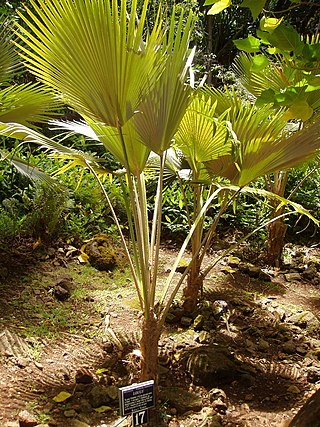
Pritchardia limahuliensis, the Limahuli Valley pritchardia, is a palm native to Hawaii. It is a rare species, only discovered in 1977 by staff of the National Tropical Botanical Garden in the Limahuli Garden and Preserve, Kauai, Hawaii, where it is now being conserved. It is threatened by introduced rats, which eat the seeds.
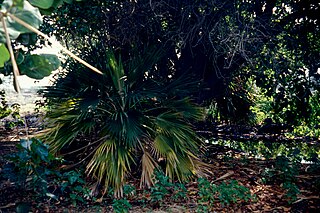
Pritchardia affinis, the Hawai'i pritchardia, is a species of palm tree that is endemic to the Hawaiian Islands. Wild populations currently exist on the leeward side of the Island of Hawaiʻi. It was most likely cultivated by Native Hawaiians, so its exact native range is uncertain. P. affinis reaches a height of 10–25 m (33–82 ft). It is threatened by rats and pigs, which damage the trees and eat the seeds before they can grow. It is a federally listed endangered species of the United States. Its fruit was reportedly the preferred food of the now-extinct ula-ai-hawane—a niche that has been seemingly filled by the introduced lavender waxbill.

Pritchardia forbesiana, the Mt. Eke pritchardia, is a species of palm tree. It is endemic to the island of Maui in Hawaii. It grows in forests. Populations are recovering since the removal of destructive feral pigs.

Pritchardia hardy, the Makaleha pritchardia, is a species of palm tree that is endemic to moist forests on the island of Kauaʻi at elevations below 2,000 feet (610 m). The trunk of this fast-growing species reaches a height of 80 feet (24 m), with a diameter of 1 foot (0.30 m). Its leaves are 3 feet (0.91 m) in length. In 1998 only 30 individuals remained in the wild along a single trail on Kauai. This is a federally listed endangered species of the United States.

Pritchardia kaalae, also known as Waianae Range pritchardia or loulu palm, is a species of palm tree that is endemic to the western part of the island of Oʻahu in Hawaiʻi. It grows near springs in the dry forests on the Waiʻanae Range at elevations up to 2,500 feet (760 m). This slow growing species reaches a height of 25 feet (7.6 m), with a trunk diameter of 1 foot (0.30 m). In 1998 there were fewer than 130 individuals remaining in the wild. This has been a federally listed endangered species of the United States since 1996.
Pritchardia lanaiensis, the Lānaʻi pritchardia, is a species of fan palm that is endemic to Hawaii in the United States. It can only be found on the island of Lānaʻi.

Pritchardia lowreyana, the Molokai pritchardia, is a species of fan palm that is endemic to Hawaii in the United States. It is found in mixed mesic and wet forests on the island of Molokaʻi. P. lowreyana reaches a height of 2–4 m (6.6–13.1 ft), and normally grows in gulches and on cliffs. It was named in 1918 for Cherilla Storrs Lowrey (1861–1918), an American clubwoman active in tree-planting and beautification projects around Honolulu.
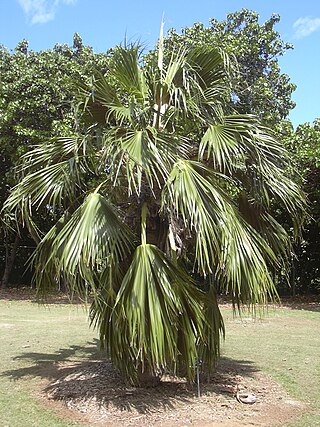
Pritchardia munroi, the Kamalo pritchardia, is a species of fan palm that is endemic to Hawaii in the United States. It is found in dry forests on the eastern (leeward) side of the island of Molokaʻi. The specific epithet, refers to James Monro, the manager of the Molokai Ranch at the time of its discovery (1920). Only two individuals exist in the wild, and both are at an elevation of 610 m (2,000 ft). It reaches a height of 4–5 m (13–16 ft) and a trunk diameter of 20 cm (7.9 in).
Pritchardia perlmanii, the Waiʻoli Valley pritchardia, is a species of palm tree that is endemic to the island of Kauaʻi in Hawaii, United States. It inhabits lowland mesic forests in the Waiʻoli Valley at an elevation of 420–850 m (1,380–2,790 ft). P. perlmanii reaches a height of 10 m (33 ft) and a trunk diameter of 30 cm (12 in).
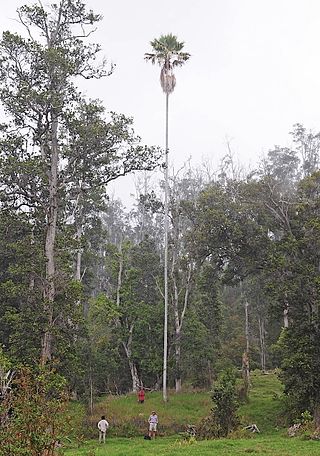
Pritchardia schattaueri, the lands of papa pritchardia or Schattauer's loulu, is a species of palm tree in the genus Pritchardia that is endemic to mixed mesic forests on the southwestern part of island of Hawaiʻi, near Kona. It is officially listed as a Critically endangered species.
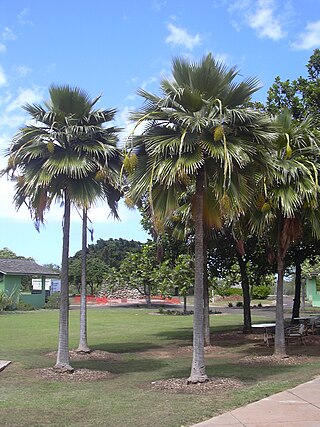
Pritchardia thurstonii is a species of flowering plant in the family Arecaceae. It is endemic to Fiji, in particular the Lau Islands. It is threatened by habitat loss.
Pritchardia waialealeana, the poleline pritchardia, is a species of palm tree that is endemic to the island of Kauaʻi in Hawaii, United States. It inhabits wet forests on the slopes of Mount Waiʻaleʻale at elevations of 500–700 m (1,600–2,300 ft). P. waialealeana, is a large palm, reaching a height of more than 20 m (66 ft).
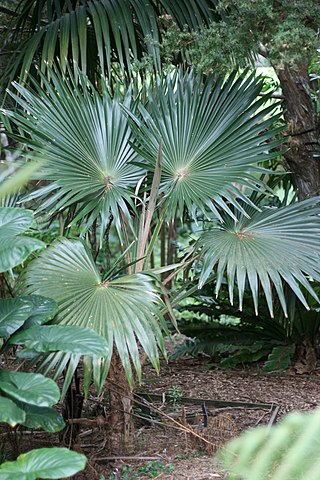
Pritchardia minor, the Alakai Swamp pritchardia or loulu, is a palm native to Hawaiʻi. It grows in wet forests in the centre of Kauaʻi at an elevation of about 1,400 metres (4,600 ft).
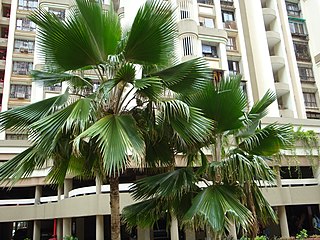
Pritchardia pacifica, the Fiji fan palm, or piu, is a species of palm tree in the genus Pritchardia that is native to Tonga. It is also found on Fiji, Samoa, and the Marquesas however these populations are likely to be human introductions.

Pritchardia beccariana, the Kilauea pritchardia, or Beccari's loulu, is a species of palm tree in the genus Pritchardia that is endemic to wet forests on the eastern part of the island of Hawaiʻi, near Hilo.

Trachycarpeae is a tribe of palms in subfamily Coryphoideae of the plant family Arecaceae. It has the widest distribution of any tribe in Coryphoideae and is found on all continents, though the greatest concentration of species is in Southeast Asia. Trachycarpeae includes palms from both tropical and subtropical zones; the northernmost naturally-occurring palm is a member of this tribe. Several genera can be found in cultivation in temperate areas, for example species of Trachycarpus, Chamaerops, Rhapidophyllum and Washingtonia.

Pritchardia mitiaroana, the Mitiaro fan palm or Iniao is a species of palm tree that is native to the island of Mitiaro in the Cook Islands. It grows on karst limestone on the island's makatea, and grows to a height of 10m.
















